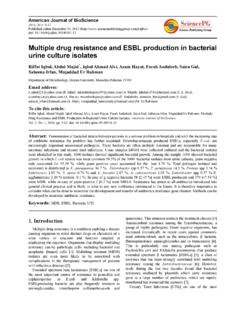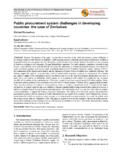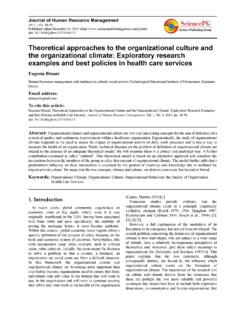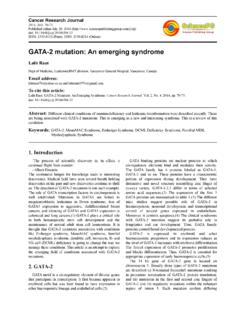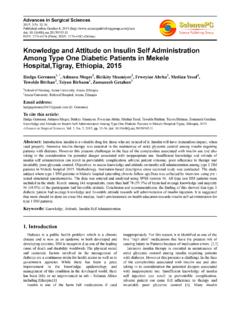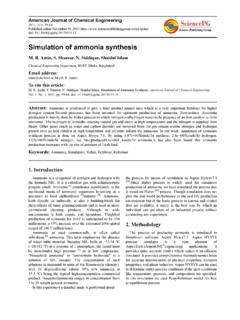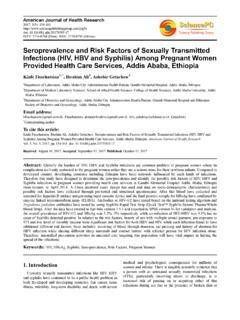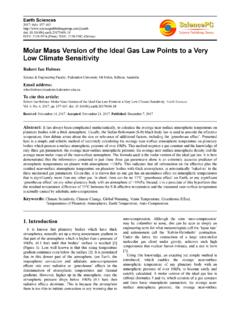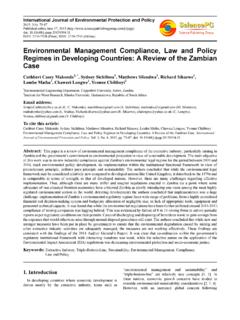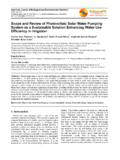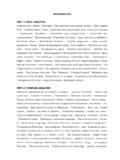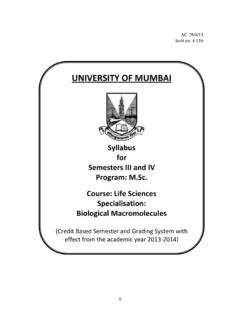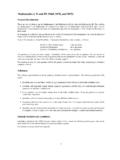Transcription of On the Riesz Sums in Number Theory - Science …
1 Pure and Applied Mathematics Journal 2015; 4(5-1): 15-19 Published online July 16, 2015 ( ) doi: ISSN: 2326-9790 (Print); ISSN: 2326-9812 (Online) On the Riesz sums in Number Theory Hailong Li, Qianli Yang Departmant of Mathematics and Information Science , Weinan Normal University, Shannxi, P. R. China Email address: (Hailong Li) To cite this article: Hailong Li, Qianli Yang. On the Riesz sums in Number Theory . Pure and Applied Mathematics Journal. Special Issue: Mathematical Aspects of Engineering Disciplines. Vol. 4, No. 5-1, 2015, pp. 15-19. doi: Abstract: The Riesz means, or sometimes typical means, were introduced by M.
2 Riesz and have been studied in connection with summability of Fourier series and of Dirichlet series [8] and [11]. In Number -theoretic context, it is the Riesz sum rather than the Riesz mean that has been extensively studied. The Riesz sums appear as long as there appears the G-function. Cf. Remark 1 and [14]. As is shown below, the Riesz sum corresponds to integration while Landau's differencing is an analogue of differentiation. This integration-differentiation aspect has been the driving force of many researches on Number -theoretic asymptotic formulas. Ingham's decent treatment [13] of the prime Number theorem is one typical example.
3 We state some efficient theorems that give asymptotic formulas for the sums of coefficients of the generating Dirichlet series not necessarily satisfying the functional equation. Keywords: Riesz Sum, Riesz Mean, Dirichlet Series, Asymptotic Formula 1. Introduction The Riesz means, or sometimes typical means, were introduced by M. Riesz and have been studied in connection with sum ability of Fourier series and of Dirichlet series [8] and [11]. Given an increasing sequence of real numbers and a sequence of complex numbers, the Riesz sum of order is defined as in [8, ] and [11, ] by ( ) where ( ) where the prime on the summation sign means that when , the corresponding term is to be halved.
4 ( ) or rather normalized which appears in (G-8-2) is called the Riesz sum of order If approaches a limit as , the sequence is called Riesz summable or summble to , which is called the Riesz mean of the sequence. Sometimes the negative order Riesz sum is considered, in which case the sum is taken over all which are not equal to . In Number Theory it is often the case that the main study of research is the behavior of an arithmetic function whose generating function is given explicitly, say in the form of a Dirichlet series or an Euler product.
5 Then the problem amounts to extracting the essential main term from the data on generating functions. In this Number -theoretic context, it is the Riesz sum rather than the Riesz mean that has been extensively studied. The Riesz sums appear as long as there appears the Cf. Remark 1. There is some mention on the divisor problem in [7] in the light of the Riesz sum and there are enormous amount of literature on the Riesz sums and we shall not dwell on well-known cases very in detail. We are concerned with the case where the generating function does not necessarily satisfy the functional equation and concentrate on asymptotic formulas rather than exact identities.
6 An example is given. Recall the definition of the periodic Bernoulli polynomial etc. ([14, ]). Then {}k {}k ( )( )()()( )()( )/1010kkkxxxA x A xxx t A t tx t A t == = = dd()()0/kkxA x A x == kx =()( )11A x + ()( )11A x +Ax {}k ()R , ,Anx1, 01,1G16 Hailong Li and Qianli Yang: On the Riesz sums in Number Theory say, or Integration of both sides amounts to ( ): where we used . The application of the Riesz sum comes into play through Perron's formula ( ) below, sometimes in truncated form. The application of the truncated first order Riesz sum appears on [10, ] and a truncated general order Riesz sum is treated in [13] in both of which the functional equation is not assumed.
7 Riesz sums with the functional equation can be found in [9], where by differencing, the asymptotic formula for the original sum is deduced. The principle goes back to Landau [15] in which one can find the integral order Riesz sum and its reduction to the original partial sum by differencing. The general formula for the difference operator of order with difference is given by ( ) If has the derivative , then ( ) The Riesz kernel which produces the Riesz sum is defined by ( ) Remark 1. Notes on ( ). Let denote the order of the Riesz mean and set.
8 Then ( ) reads () ( ) This can be found in Hardy- Riesz [11] and Chandrasekharan and Minakshisundaram [8] and used in the context of Perron's formula ( ) where the left-hand side sum is called the Riesz sum of order and denoted as mentioned above and . The special case of ( ) with is known as the discontinuous integral whose truncated form can be found in Davenport [10, ]. This and the general case ( ) can be proved by the method of residues, distinguishing the cases and . Here as above, the prime on the summation sign means that when , the corresponding term is to be halved, and this halving comes from the peculiarity of the discontinuous integral.
9 If the order , then the right-hand side member of ( ) is and the Riesz sum amounts to the times integration of the original sum . Thus Landau's differencing is an analogue of the integration and differentiation. In view of this integration-differentiation aspect there are a Number of cases in which the Riesz sum appears in disguised form. Especially, when there is a gamma factor or involved. The very special case of ( ) (and of the corresponding logarithmic case () presents excessive complexities in notation, so that we follow Hardy and Riesz [11] to use ( ) by suppressing the prime on the ()()()/11 :n xB xxA x === ( )( )()( )11,1,2A xxB x B xA xx = + ( )( )( )( )()( )()22110011d22dxxn xB t B tB t B t tA t tx n = == ( )( )2221006 BBB === 0y ( )()() xf x y = = + fth ()f ( )( )( )1112ddd.)
10 X yx yt yyxxtf xttf t t +++= ()()11,01,111,111,120,1a bbz zza baG zz a bbz < === + > 00,1b a ==+0c>( )()()()11,111d,0,12120,1scz zsz szi sz < === ++ > +1()()()()()'11d ,21kssncxs F s xxz sis + = ++ +1 ()A x ( )1kskF sk == = 01z<1z>kx = ()()11d ,2scz si s ss + + 1 ()A x ()()1ss ++10 + 1,1z a b=+=1,1z m==Pure and Applied Mathematics Journal 2015; 4(5-1): 15-19 17 summation. We are to bear this special case in mind although not explicitly stated. Remark 2. The Riesz summability is useful in summability of (Fourier) series.
